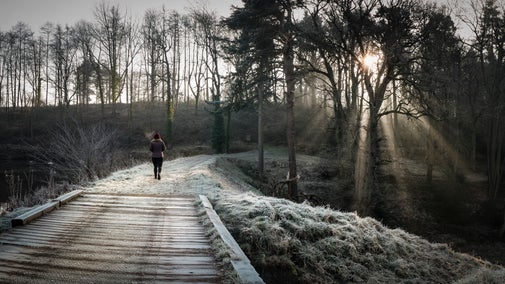
Discover more at Dudmaston
Find out when Dudmaston is open, how to get here, things to see and do and more.

Discover more about how we’re using traditional farming methods to increase wildflowers in the hay meadows we care for. Find out how sheep have been helping with conservation grazing across the woodland in The Dingle to improve biodiversity. Learn more about how the woodland management plan provides fuel for the biomass boiler and works towards our green energy vision.
Today, only 2% of the meadows that existed in the 1930s remain, we’ve lost around 7.5 million acres of wildflower meadow. Hay meadows and species-rich grasslands may be declining nationally, but at Dudmaston we're working with our farmers to restore this rare and important habitat.
At Dudmaston we have many meadows bordering the river Severn. Our aim is to restore species-rich floodplain meadow. Working with our tenant farmer Martin we have sowed many kilograms of wildflower seed. The meadow will be cut for hay in late July, early August.
In a corner of the meadow was the indentation of an old pond. We have restored this pond and planted several aquatic plants. This will be a habitat which should prove a haven for wildlife and therefore increase biodiversity in the area.
The woods here at Dudmaston have a plan that records what makes them special, their history, wildlife and existing tree species. The plan describes how we will manage the woodland and what the future may look like. We consider changing climate, pest, diseases and what we want the woodland to look like in the future. We need to carefully manage woodlands that will be healthy for wildlife and for people.
Each winter we thin the woodland to allow the mature trees room to grow and young saplings enough light to able to develop. This will ultimately creating a better range of ages amongst the trees. With the increase in space and light there will be an increase in woodland flora and wildlife. We hope to encourage more butterflies like the White Admiral and woodland flowers.

The Dingle is a rare and important landscape, a feature typical of the Picturesque movement in garden design that first became fashionable in the late 18th century. The idea was to create an artificial landscape that looked natural. Paths, seats and bridges were positioned to enable people to enjoy the area from different viewpoints.
Since its creation the valley has become overgrown, and its features have been lost. Over the years the valley has been used for growing commercial forestry and its original aesthetic beauty has been obscured. The Rangers are gradually restoring it to an interpretation of its original landscaped condition. Many of the self-set Ash trees have succumbed to ash die back and have been removed for safety reasons. We have built a secure boundary fence and our flock of Hebridean sheep help prevent The Dingle from becoming overgrown and reduce the time the Rangers spend on mechanical cutting.
This clearing of overgrowth will increase the space and light available for wildflowers such as red campion and yellow archangel.
Using reference points from the past we hope to restore the Dingle back into a lightly wooded valley with plentiful ground flora, where the babbling brook flows under bridges and on past rocky outcrops. It already boasts areas of quiet where visitors can contemplate and commune with nature.

Our biomass boiler system that uses woodchip from the estate saves on bills and reduce carbon emissions. This renewable energy source fits in with our vision to reduce the use of fossil fuels and find local renewable alternatives.
The biomass system is fuelled by wood grown right here on the estate. Trees are cut down as part of regular woodland work which helps with new growth and biodiversity. The wood is chipped, dried to a specific moisture content and then used to fuel the boiler.
The biomass system is used to heat the house and galleries to the correct levels needed to conserve the collections, and offer comfort to visitors.
As a result Dudmaston no longer uses large quantities of oil for heating and this reduces our carbon emissions and energy bills. The biomass system helps our aim to cut our carbon emissions from heat and electricity by 45 per cent.
With your ongoing support, we're able to continue our vital conservation work. Thank you for helping to protect these special places.

Find out when Dudmaston is open, how to get here, things to see and do and more.
From the Norman knight where it all started to the 200-acre wood that saved it from ruin, learn about Dudmaston’s history.

A family home at the centre of rural Shropshire life, Dudmaston also houses one of the most important private collections of modern art in Britain. This is a house of many contrasts, lived in by the same family for over 875 years.

Get away from it all and enjoy a little peace and tranquility in the garden complete with views as far as the eye can see and a love of art that seeps through.

Find out how you can volunteer and help all visitors to enjoy this special place and make new friends at the same time.

Read about our strategy, which focuses on restoring nature, ending unequal access and inspiring more people.

We believe that nature, beauty and history are for everyone. That’s why we’re supporting wildlife, protecting historic sites and more. Find out about our work.
